If you’re planning a trip to Puerto Rico and your weather app shows rain clouds every single day, don’t panic—you’re not alone in that anxiety. As a travel specialist who’s spent over a decade exploring the Caribbean, I can tell you that understanding the Puerto Rico weather is one of the most misunderstood aspects of planning this incredible trip. That 70% chance of rain doesn’t mean what you think it means in a tropical climate. This guide will decode the island’s unique weather patterns, explain its fascinating microclimates, and show you exactly how to prepare for your visit any time of year. By the end, you’ll understand why that intimidating forecast is actually nothing to worry about and how to plan the perfect Puerto Rico adventure with confidence.
Understanding Puerto Rico’s Climate: Year-Round Tropical Warmth
Puerto Rico operates under a tropical marine climate, which essentially means one glorious season: endless summer. The average temperature in the coastal areas hovers around to ( to ) throughout the entire year. Unlike the mainland U.S., there’s no dramatic temperature swing between seasons—the difference between the coolest and warmest months is only about (). January’s average low sits around (), while the hottest months of June or August reach highs around ().
The secret ingredient making this year-round heat so comfortable is the constant easterly trade winds sweeping across the island from the Atlantic. These breezes act as nature’s air conditioning, transforming what could be oppressive humidity into a wonderfully pleasant tropical warmth. An day with 80% humidity that would feel stifling in Houston feels energizing and inviting in San Juan, thanks to that persistent ocean breeze providing natural evaporative cooling.
What 85°F Really Feels Like in Puerto Rico
Here’s something most weather apps won’t tell you: temperature numbers don’t translate the same way in different climates. That reading in San Juan feels completely different from the same temperature inland on the mainland. The combination of constant trade winds and proximity to the ocean creates a warmth that energizes rather than drains you. It’s the kind of heat that makes you crave a cold drink and a dip in the ocean, not a retreat into air conditioning.
The ocean itself is a constant invitation to cool off, with water temperatures ranging from a refreshing to ( to ) in winter months to a bath-like () in September and October. Swimming, snorkeling, and water activities are delightful year-round.
One serious consideration: Puerto Rico experiences a very high to extreme UV index ranging from 10 to 12 throughout the year. The sun is most intense between 10 AM and 4 PM, making broad-spectrum, reef-safe sunscreen of at least SPF 50+, polarized sunglasses, and a wide-brimmed hat absolute necessities.
Best Time to Visit Puerto Rico: Weather vs. Deals
The honest answer to “when should I visit Puerto Rico?” depends entirely on what matters most to you: pristine weather, lower prices, or fewer crowds. The island is fantastic year-round, but the experience changes dramatically with the seasons.
High Season (December – April): The Driest Weather
This is Puerto Rico’s peak tourist season for excellent reasons. From mid-December through April, the island delivers its driest, sunniest, and least humid weather. Days are typically bright and breezy, with comfortable temperatures perfect for hiking in El Yunque, exploring Old San Juan’s cobblestone streets, or simply beach lounging. This is when the Puerto Rico weather is at its most stable, and travelers who visit during this window consistently describe it as “lovely” and ideal.
The trade-off? This is the most expensive time to visit. Flights and hotel rates peak, and popular attractions, beaches, and restaurants bustle with tourists. If your primary goal is escaping winter cold and you don’t mind paying premium prices for near-perfect weather, this is your window.
Low Season (May – November): The Best Deals
The low season coincides with the rainy and hurricane seasons, but this is when smart travelers find incredible value. Temperatures and humidity climb, and rain chances increase—but so do the rewards. You’ll find significantly lower accommodation and airfare prices, and the island takes on a more relaxed, authentic local feel with far fewer tourists.
This season requires more flexibility and willingness to embrace the tropical climate in its truest form, but the payoff can be deeply rewarding. Budget-conscious travelers, those seeking cultural immersion, or anyone preferring quieter vacations will find this the ideal time.
The Truth About Rain in Puerto Rico: Decoding the Forecast
This is where most pre-trip anxiety originates: that dreaded forecast showing a 60%, 70%, or even 80% chance of rain every single day. This is the most misunderstood aspect of Puerto Rico weather, and where firsthand experience becomes critical.
A high probability of precipitation in a tropical marine climate does not mean what it means in places like New York or Chicago. It doesn’t signify full days of gloomy, persistent drizzle. The high humidity and tropical heat create conditions where rain forms easily and quickly, but this rain almost always manifests as brief, intense, highly localized showers called aguaceros.
These aren’t day-ruining events. As countless travelers attest, the typical pattern is a sudden downpour lasting 15 to 30 minutes, followed by the swift return of brilliant sunshine. One recent visitor shared: “Just got back on Monday. It rains every day for about 20 minutes and then the sun starts blasting. I was there for ten days and we only had two days where it poured for more than an hour.”
Another traveler explained it perfectly: “Tropical rain clouds are tiny. It can be raining here and not raining two blocks away.” The fundamental issue is data interpretation. Weather apps see high atmospheric moisture and correctly predict high rain chances somewhere in the forecast area at some point during the day. The app displays a rain cloud icon, which travelers from non-tropical climates interpret as a “rainy day.” The crucial missing context is the nature of that rain—its brief duration and highly localized behavior.
How to Manage Puerto Rico’s Tropical Weather
The most valuable skill you can develop is seeing that 70% rain icon not as a threat, but as a prediction of a brief, refreshing afternoon shower that will quickly pass. Ditch the 10-day forecast and use a real-time radar app like MyRadar, frequently recommended by locals. This lets you see the actual size, speed, and direction of rain cells. You can watch a small storm approach, take a 30-minute coffee or rum punch break, then head right back to the beach as it passes. This is actively managing the weather rather than letting misleading forecasts manage you.
Month-by-Month Guide to Puerto Rico Weather
While the Puerto Rico weather stays generally consistent, subtle shifts in temperature, humidity, and rainfall define each month’s character. Here’s what to expect throughout the year.
December, January, February: Dry & Breezy Winter
This is the heart of the high season and what many consider climatic perfection. The air feels clean and fresh, with humidity at its lowest point all year. Constant trade winds feel particularly refreshing. Daytime highs rest comfortably in the low (around ), while evenings can dip into the low (around )—cool enough for a light sweater in breezy restaurants. Rainfall hits its minimum, with January and February being the driest months at only about 1.3 inches of precipitation each. This is ideal timing to escape mainland winter cold, with weather perfect for all-day activities from hiking to city exploration without oppressive summer heat.
March, April, May: A Beautiful Spring Shoulder Season
This period marks a gradual transition from the dry high season to the wetter low season. March and April continue the beautiful, mostly dry weather trend, with temperatures slowly creeping upward. May is the pivot month, officially marking the rainy season’s start. You’ll notice distinct increases in both humidity and afternoon shower frequency, with monthly rainfall jumping significantly to around 6 inches in some areas. One traveler noted that early April was fantastic, with temperatures never exceeding . March and April offer a great balance between high-season weather and slightly thinning crowds. May is somewhat of a gamble—you could be rewarded with beautiful weather and lower prices, or experience the season’s first consistent rains.
June, July, August: Hot & Humid Tropical Summer
Welcome to true tropical summer. Heat and humidity are undeniable, but so is the island’s energy. These are typically the hottest months, with daily highs consistently reaching the upper and pushing into the low (). Humidity is palpable, and afternoon thunderstorms become regular features. The ocean reaches its absolute warmest at (), making it the perfect escape from the heat. This is when the island truly comes alive with local life. As one observer noted: “Expect high humidity and more local activity, as Puerto Ricans take time off to vacation. You’ll notice the stunning beaches are full of local families.” Plan your days around water activities, getting out early and embracing the rhythm of afternoon showers followed by warm, vibrant evenings.
September, October, November: Peak Rainy Season & Great Deals
This is the wettest part of the year and the hurricane season’s statistical peak, but it also offers the best deals for flexible travelers. September is historically the rainiest month, averaging nearly 5 inches of precipitation island-wide, with October close behind. The weather remains very warm and humid. While rain chances are high, remember it still often comes in those characteristic bursts rather than all-day deluges. As one guide points out: “Rainfall usually does not last for long periods of time and is often followed by sunny intervals.” This season demands the most flexibility. You might change plans on the fly, but you’ll be rewarded with the fewest crowds and lowest prices all year.
Hurricane Season in Puerto Rico: A Practical Guide
The word “hurricane” understandably triggers anxiety, but when planning travel, it’s essential to separate emotional weight from statistical reality and modern management tools.
Understanding Hurricane Risk vs. Perception
The official Atlantic hurricane season runs from June 1 through November 30, with the statistical peak from mid-August through mid-October. The Puerto Rico hurricane season falls squarely in this window. The island sits in a hurricane-prone region and has been hit by devastating storms including Hugo (1989), Georges (1998), Irma (2017), the catastrophic Maria (2017), and recently Fiona (2022).
However, direct hits by major hurricanes are not annual occurrences. The most critical fact: unlike earthquakes or tornadoes, hurricanes aren’t surprise events. Modern forecasting from the National Hurricane Center provides 3- to 5-day warning windows for any approaching storm. This advance notice is key to safety and flexible planning.
The decision to travel during this season isn’t a blind gamble—it’s a calculated risk management exercise. The primary risks are travel disruption and potential service loss, not being caught unaware. By using available tools—forecasting, insurance, and flexible booking—you’re not betting a storm won’t form. You’re creating a plan to manage potential outcomes if one does, allowing you to enjoy a less crowded, more affordable vacation.
Safety Checklist for Hurricane Season Travel
If you travel during this season, preparation is everything:
- Buy comprehensive travel insurance: This is non-negotiable. Ensure your policy explicitly covers trip cancellations and interruptions due to hurricanes. Read the fine print carefully.
- Book flexibly: Choose airlines and hotels offering lenient cancellation or change policies whenever possible, mitigating financial risk if plans need altering.
- Stay vigilantly informed: In the week before departure, make monitoring the National Hurricane Center a daily habit. Once on the island, pay close attention to local news and enable severe weather alerts on your smartphone.
- Choose accommodations wisely: Ask about hurricane preparedness when booking. Do they have backup generators and water reservoirs (cisterns)? What’s their emergency plan for guests? Reputable hotels have this information readily available.
- Consider your location: A crucial tip from local residents: stick closer to the San Juan metro area if storms threaten. Infrastructure is more robust, and getting airport transportation for potential evacuation is significantly easier.
Puerto Rico’s Microclimates: Coast vs. Mountain Weather
One of the most fascinating aspects of Puerto Rico weather is how dramatically it changes over very short distances. You can drive 30 minutes and feel like you’ve entered a different climate zone—and you basically have, thanks to the island’s unique topography.
The key to understanding these microclimates is the Cordillera Central, a mountain range running east-to-west through the island’s center. This range acts as a massive barrier to moisture-laden trade winds blowing from the northeast. As winds rise over the mountains, the air cools and releases moisture as rain, creating a lush, wet climate on the northern side and a much drier, sunnier “rain shadow” on the southern side.
The Lush and Rainy North (San Juan, Dorado)
This region, including the capital San Juan, receives the brunt of trade wind moisture. The result is a verdant, tropical landscape exemplified by El Yunque National Forest. It experiences more rainfall and is often slightly cooler and cloudier than the south.
The Dry and Sunny South (Ponce, Guayama)
Protected by the Cordillera Central, the southern coast is a world away. This is the island’s driest part, with some areas classified as semi-arid. It receives significantly less rainfall, resulting in more desert-like vegetation and a higher probability of sunny days. Temperatures here consistently run a few degrees warmer than in the north.
The Cooler Central Mountains (Adjuntas, Jayuya)
As you ascend into the Cordillera Central, the elevation brings noticeable temperature drops. The climate is cooler and wetter, with misty mornings and evenings that sometimes dip into the or even (). This cool, moist environment is perfect for growing coffee, and the region is dotted with historic haciendas.
The Breezy East and Islands (Fajardo, Vieques, Culebra)
The eastern coast and offshore islands of Vieques and Culebra are the first to greet the trade winds, making this region feel noticeably breezier. It’s subject to frequent but typically fast-moving rain showers. Culebra and Vieques have their own distinct tropical monsoon climates, characterized by year-round warmth, high winds, and a rainy season from May to October.
For travelers prioritizing sunshine above all else, choosing a base on the southern coast can dramatically increase clear sky chances. The San Juan weather on the north coast includes substantially more rainfall than Ponce on the south coast—a stark illustration of the rain shadow effect.
Essential Packing and Safety Tips for Puerto Rico Weather
Being prepared for the Puerto Rico weather doesn’t mean packing for every possible scenario. It means understanding the most likely situations and having the right gear and knowledge to handle them comfortably and safely.
Ocean Safety: Rip Currents and Beach Flags
Even on perfectly sunny days with no storms in sight, the ocean can pose serious threats. Large swells generated by distant hurricanes hundreds of miles away in the Atlantic can travel across the ocean and create powerful, life-threatening rip currents along Puerto Rico’s northern and eastern coasts. Never underestimate the ocean’s power.
Familiarize yourself with Puerto Rico’s beach flag warning system:
- Green Flag: Low hazard. Wind and wave conditions aren’t expected to create dangerous rip currents, but caution is always advised.
- Yellow Flag: Medium hazard. Conditions support stronger or more frequent rip currents. Only experienced surf swimmers should enter the water.
- Red Flag: High hazard. Dangerous, life-threatening rip currents are present. No one should enter the water.
Rainforest Ready: What to Expect in El Yunque
El Yunque is the only tropical rainforest in the U.S. National Forest System, and the keyword is rain. It rains here on average four times daily, accumulating over 100 billion gallons annually. Expecting to stay completely dry is unrealistic—embracing the rain as part of the magical, misty experience is the right mindset.
- Footwear is paramount: Trails are often wet, rocky, and muddy. Sturdy, closed-toe hiking shoes with excellent grip are essential for safety and comfort.
- Dress for a drenching: Many experienced hikers skip heavy raincoats in favor of lightweight, quick-drying, moisture-wicking activewear. The rain is warm, and in high humidity, heavy jackets feel stifling. It’s often more comfortable to simply get wet and dry off quickly.
- Plan ahead: Conditions change instantly. Before driving up, always check the official U.S. Forest Service website for the latest trail closures or hazardous condition updates. Cell service is extremely limited to non-existent within the forest, so download maps or trail guides to your phone beforehand.
The Ultimate Weather-Ready Packing List
Based on years of travel and feedback from countless visitors, here is the definitive packing list for Puerto Rico:
Clothing:
- Lightweight fabrics: Breathable materials like cotton, linen, and rayon for daytime wear.
- Activewear: Quick-drying, moisture-wicking shirts and shorts for hiking and adventures.
- Rain gear: A light, packable rain jacket or poncho for city downpours.
- Extra layer: A light sweater, sweatshirt, or jacket for cooler mountain evenings or powerful restaurant air conditioning.
Footwear:
- Comfortable sandals or flip-flops for the beach and casual wear.
- Water shoes for rocky coastlines or riverbeds.
- Closed-toe hiking shoes or sturdy sneakers for El Yunque and other trails.
Protection:
- High-SPF (50+), broad-spectrum, reef-safe sunscreen.
- Polarized sunglasses and a wide-brimmed hat for intense UV rays.
- Insect repellent, especially for jungle hikes and coastal evenings.
Gear:
- Waterproof dry bag or Ziploc bag to protect your phone and wallet during showers or boat trips.
- Reusable water bottle for staying hydrated in the heat.
- Portable power bank (power outages can occur, especially during storms, making backup charging invaluable).
Final Thoughts on Puerto Rico’s Weather
The dynamic Puerto Rico weather isn’t an obstacle—it’s the very essence of its tropical allure. The island offers the gift of an “endless summer,” with its true beauty lying in its vibrant nature. The key to a perfect trip is understanding these weather patterns rather than fearing the forecasts. The rain appearing on your weather app is the lifeblood of El Yunque’s impossibly green rainforest, the heat and humidity warm the Caribbean Sea to bath-perfect temperatures, and the constant trade winds remind you you’re on a tropical island far from the mainland. You’re now armed with seasoned traveler knowledge, understanding the island’s microclimates and the truth about tropical rain. You’re prepared to navigate any season with confidence and respect for nature’s power. Go forth and plan an incredible, unforgettable Puerto Rico adventure—the island is waiting for you, rain or shine.
Read more:








